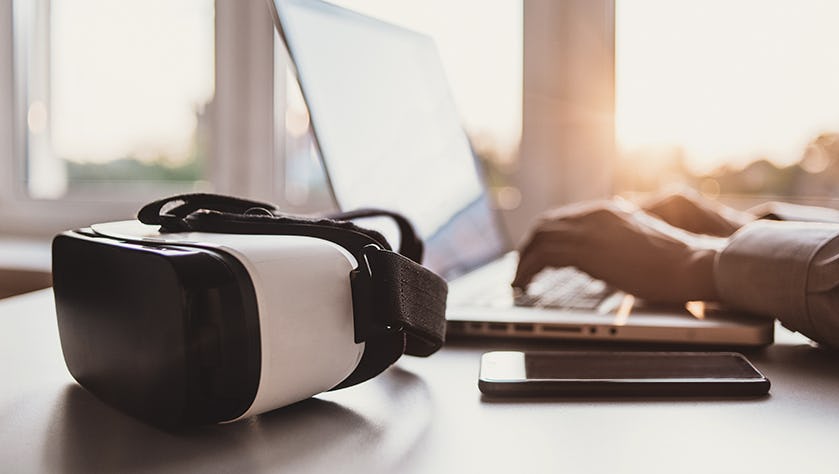
From holographic colleagues to virtual reality meetings, we explore what the hybrid working revolution could mean for the future of the office
There’s no denying that the past 18 months have shaken up the way we work. Instead of commuting for hours each day, employees have been able to work in their slippers and take lunch straight from the fridge. Crucially, many companies have seen the benefits that remote work can bring for their bottom lines, as well as staff satisfaction.
So does this mean working from the office is over? Not quite. The hybrid approach, which allows employees to combine working from home, from the corporate HQ and from a local office or flexible workspace, is set to offer the best of both worlds for people who want out of the rat race but still need to collaborate with colleagues face to face.
According to the Office for National Statistics, 85% of adults who worked from home during periods of lockdown want to stick with hybrid working, and businesses as diverse as Amazon, Facebook and Ford have already announced plans to give employees more control over where they are based.
A change in function
Prior to the pandemic, offices were largely designed to be functional, with open-plan settings, row upon row of desks and limited private offices or meeting space.
However, as offices slowly reopen business leaders are starting to rethink how they’re designed.
With focused work likely to be undertaken from home or a local flexible workspace, offices are likely to have fewer people in them on a day-to-day basis – and businesses including BP and JP Morgan Chase have already announced plans to scale back their real estate footprints in line with reduced need.
Collaboration and creation
“In-office collaboration will be just as important to Google’s future as it’s been to our past,” said Google CEO Sundar Pichai in an email to employees, underlining the ongoing role of the corporate HQ within the firm’s hybrid model. However, the key word here is collaboration: the office of the future will primarily be a space for interaction and connection, made up of areas dedicated to discussion, equipped for active work and designed to inspire creativity.
“From our studies, we can see that previously people spent 70% of their working hours carrying out work processes, and 30% of their time collaborating with colleagues,” says Alain Dehaze, CEO of Adecco Group. “Now this will be reversed, with people coming into the office to collaborate, work on projects [and be creative]. Work processes [will be] done in a remote way, eliminating travel time, boosting productivity and enhancing quality of life.”
It’s also worth noting that, in a hybrid world, colleagues who live within the same region can use local flexspaces to support one another or chew over challenges. NTT signed a groundbreaking deal with IWG earlier this year to give its 300,000+ employees access to flexible workspace locations. The firm is now developing an app to help staff identify which colleagues are at which flexspaces so that they can link up if desired.
Hygiene in the hybrid future
Post-pandemic, businesses will also be looking to shore up their spaces’ hygiene and safety features – not only to protect against Covid-19 infections, but in preparation for other, similar events that might arise. “The office of the future will be shaped from the lessons learned today and with future pandemics in mind,” according to Morgan Lovell.
Touch-free tech that allows contactless entry into workspaces, as well as no-touch lights, lifts and locks may become common. Workplace IDs and passes may be replaced by smartphone apps that also act as digital ‘keys’ for operating doors.
Meanwhile, UV light machines could be used to blitz offices after home time, killing bacteria and viruses to help keep people safer.
Keeping people connected
The workplace of the future will “continue to bring humans and machines closer together,” says Morgan Lovell.
In years to come, virtual reality and augmented reality setups may become common tools for keeping distributed teams connected. Facebook has already developed Infinite Office – a tool that allows remote workers to blend virtual reality into their real-life environment. Meanwhile, Spatial can create holographic avatars of colleagues so that team members can ‘work together’ on projects.
For now, though, most firms are prioritising platforms such as Slack, Asana, Microsoft Teams and Trello, ensuring they are available and working well for hybrid teams. These tools enable workers who are based in disparate locations – and who might not work the same hours – to stay on top of project progress. Chat functionalities can help to meet the need for quick check-ins that can be difficult to have outside the office.
Because it’s worth it
Morgan Lovell is clear that the corporate offices of the future “need to become destinations”. Given the extra effort employees must make to get there, “the benefits reaped [should] make it truly worth the extra bother”.
Tech giants such as Google and Amazon have long been engaged in a race to add more and more outlandish features to their offices, with free food, on-site yoga classes and giant greenhouses all part of their plans for attracting top talent.
While not every company can offer such excitement, making visits to the corporate HQ feel special should be a priority for any firm. Getting together at the office should provide employees with opportunities to bond and help to embed company culture.
The rest of the time, freeing staff to work wherever suits them best will provide the boosts to wellbeing and productivity that both employees and employers want from the new, hybrid world. At Spaces, workers can expect stylish surroundings, impeccable service, abundant greenery and excellent coffee – all of which help to make a visit to a local flexspace feel special.
Enjoy this? You might also like these other Spaces magazine stories:
Upskill from anywhere: how the hybrid revolution has transformed professional development
Smart ways to boost your wellbeing when you return to the office
Share this article
 Read now How to reconnect with your colleagues
Read now How to reconnect with your colleagues
 Read now Top tools to improve your time management
Read now Top tools to improve your time management